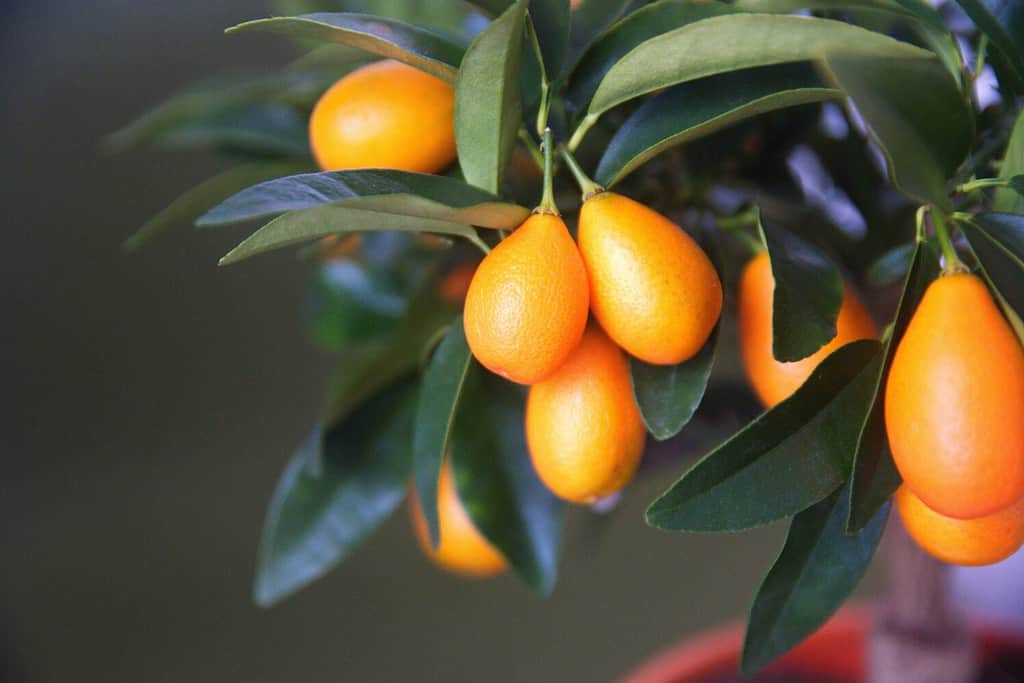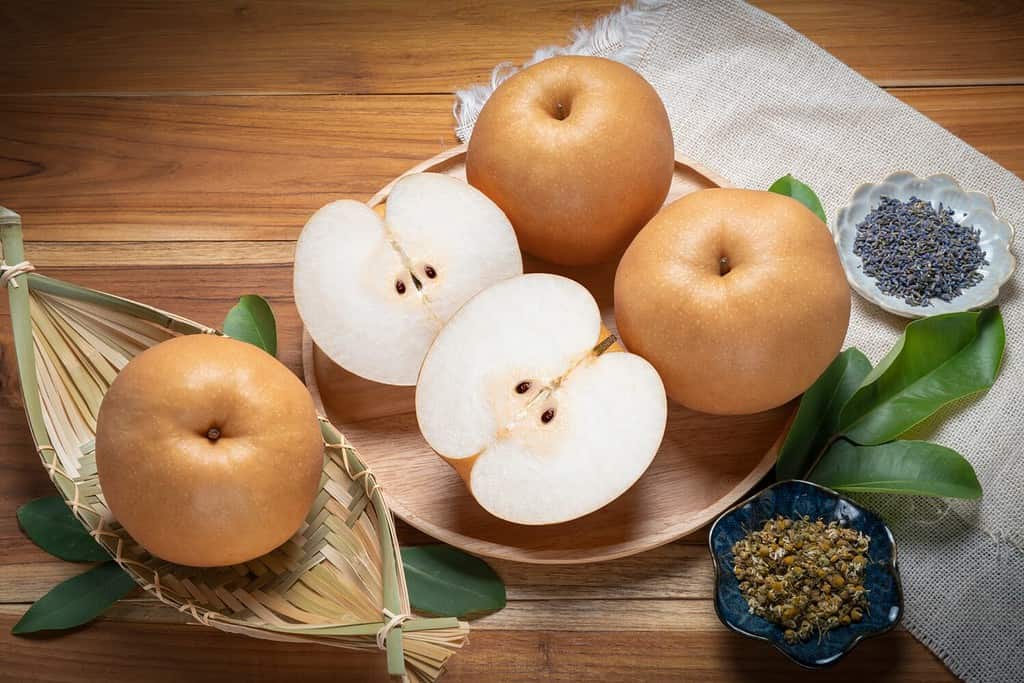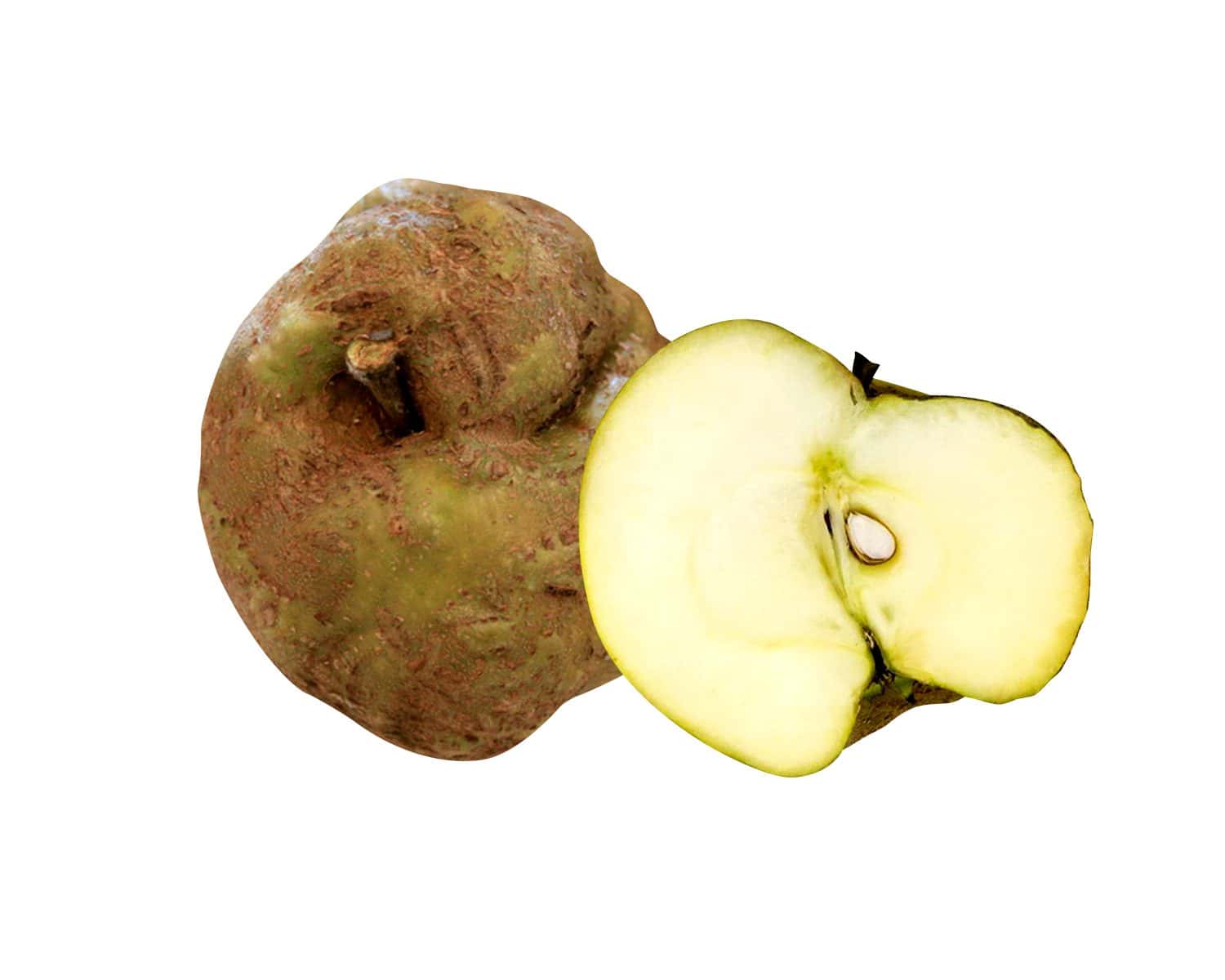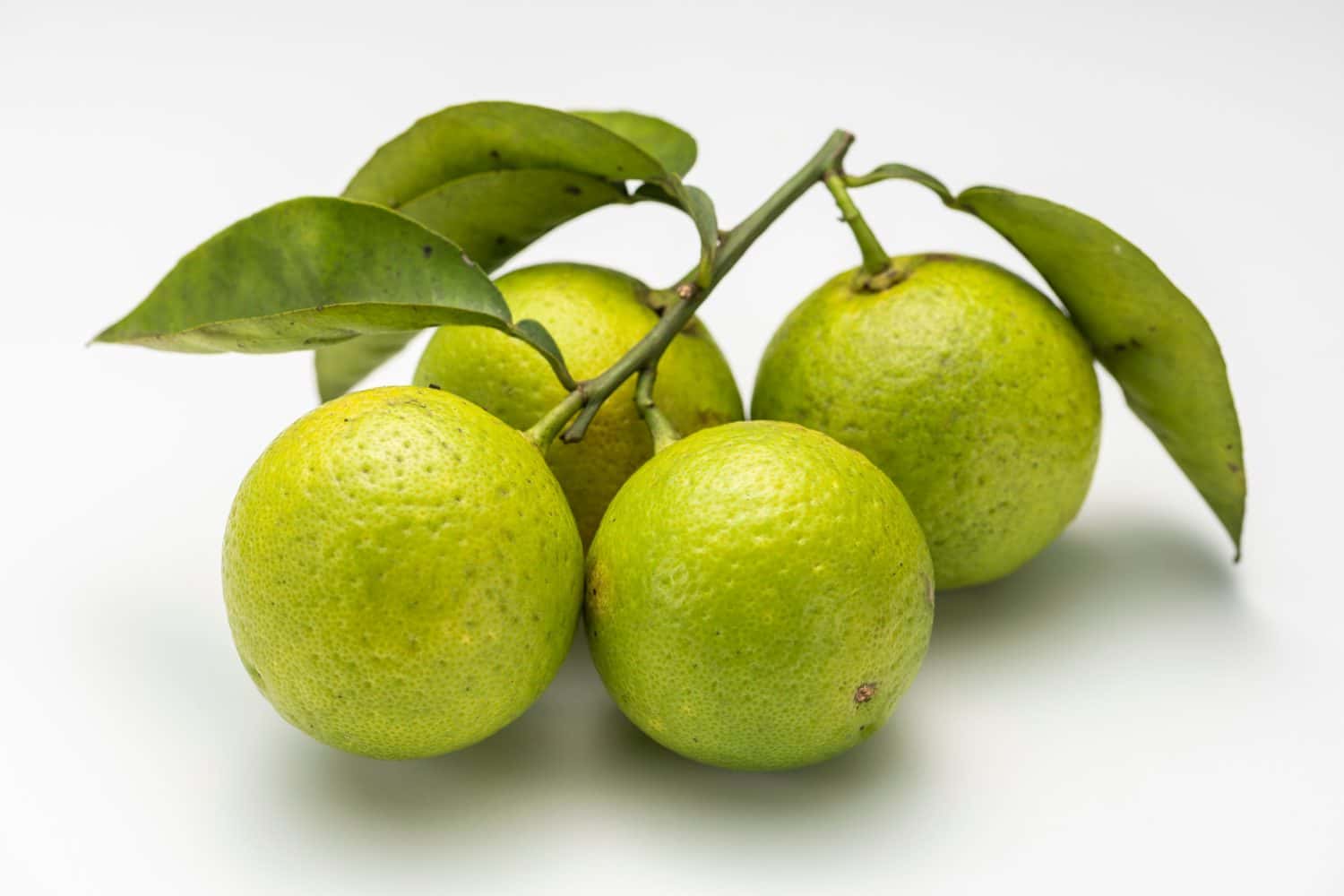Fruit is the primary mechanism whereby plants reproduce, but they’re so tasty that animals (including us!) eat many before they can sprout. Let’s discover 34 fruits that start with K, from the obvious kiwi fruit to more obscure fruits you’ve not heard of before.
What Is Fruit?
Fruit is the fleshy part of a flowering plant’s ovary. It encases at least one seed and matures after the flower is pollinated. When a fruit falls to the ground, it decomposes, giving the encased seeds enough soil to sprout and grow.
Fruit is a major part of animal diets. It contains healthy vitamins, minerals, and fiber, and very little sodium, fat, or cholesterol. However, not all species can eat fruit. Omnivorous dogs, for example, cannot eat cherries or grapes without serious consequences.
So, now we know what fruit is, here are 34 fruits that start with K.
1. Kiwi

Kiwi fruits grow on a vine. Their flesh, skin, and seeds are edible.
©iStock.com/YayaErnst
Perhaps the one we think of first is a kiwi fruit. Also called the Chinese gooseberry, this tasty fruit that starts with K is about the size of an egg, but instead of a smooth shell it has brown fuzzy skin.
Inside, a kiwi is bright green with lots of juice and tiny black seeds. It grows on a tree branch, hanging down in clusters.
It’s native to China, and cited in 12th-century manuscripts, but it didn’t become popular in the Western world until British and American soldiers discovered it in New Zealand during WW2. From the 1960s, kiwi fruit was exported to Britain and the United States where their exotic flavor was instantly popular.
2. Kumquat

Citrus fruit kumquats look like oranges but taste sweeter.
©aniana/Shutterstock.com
Resembling a small orange, citrus fruit kumquats taste similar, but have a special, sweet flavor of their own.
Kumquat is native to Southern China and like kiwi has been mentioned in manuscripts since at least the 12th century. Robert Fortune, a plant collector, brought the first kumquat tree to England in 1846.
The tree reaches about 8-14 feet tall and produces glossy leaves with small white flowers that ripen to kumquats if pollinated. The best way to eat a kumquat is fresh, but they make excellent stewed fruits and bring a bit of sweetness to salads and Asian-inspired dishes, too.
3. Korean Pear

Korean pears aren’t actually pears, but a different fruit species.
©MERCURY studio/Shutterstock.com
No surprise this fruit that starts with K is native to Korea (and wider Asia), but it’s not actually a pear. In fact, it resembles an apple with a very high water content.
Korean pears are difficult to find because they bruise easily and stores aren’t keen to waste money on damaged fruit, but if you manage to find one, eat it fresh. Korean pears are so watery they don’t cook well. The fruit inside is crisp and crunchy.
4. Key Lime

Key limes are highly acidic and excellent in cocktails.
©ANEK SANGKAMANEE/Shutterstock.com
This is a popular fruit in cocktails and key lime pie, but despite being named after Florida Keys, did you know it’s actually native to Southeast Asia?
This lime has thinner skin than others, more seeds, and it’s more acidic. Green key limes are not ripe, they turn yellow when mature.
Key lime trees reach around 16 feet tall and they never have a straight, smooth trunk. Instead, a crooked trunk develops many twists, turns, and nodules. Key limes are pretty easy to grow in Florida and southern states that experience mild winters.
5. Kaffir Lime

Kaffir lime foliage was used to deter leeches and mosquitoes.
©Worraket/Shutterstock.com
Another lime, but this time it’s a rough and bumpy sweet lime. Native to tropical southeast Asia, this lime, and especially its foliage, is popular in soups, curries, and salads.
When its leaves are crushed, its essential oil smells pungent and intense. It was used to fend off biting bugs and land leeches in the past, and today, it’s a popular ingredient in perfumery and oils.
6. Knobbled Russet Apple

Knobbled russet apple is not a popular eating apple due to its warty exterior.
©Amir7287/Shutterstock.com
Not just a description, but a proper name!
Knobbly (or knobbled) russet apples don’t look all that appetizing. This fruit beginning with K is a small round apple with green skin and a layer of russet that covers the apple in bumps, protrusions, and ribbing, hence the name “knobbly”.
It’s a tart, crisp eating apple under its unusual warty skin, with tasty spice notes. In the past, people grew it because it stores so well, but today, it’s less popular due to its somewhat ugly appearance.
7. Kabosu

Kabosu fruit is a cross between bitter orange and yuzu.
©kai keisuke/Shutterstock.com
This is a Japanese citrus fruit frequently used in the East to make juice and tangy sauces. Its taste is sharp and sour like lemons. Experts think this fruit beginning with K is a chance-occurring bitter orange/yuzu hybrid.
It’s picked from the crooked, evergreen tree whilst green and left to ripen yellow, but even when it’s ripe this citrus fruit remains sharp and tart. It’s prized in fish dishes to cut down fish odors.
8. Kutjera

Kutjera is a type of Australian bush tomato.
©xSquared/Shutterstock.com
A sweet and tangy fruit that’s better known as the Australian desert raisin.
This arid area fruit is called a “bush tomato” by native groups that have eaten and stored it for thousands of years. It’s a member of the solanum family of tomatoes and potatoes, and over 100 species exist in the bush. However, only six are edible, and kutjera is the most popular.
This shriveled vitamin C-rich fruit looks like a raisin, but tastes like caramel. A powdered version is readily available in stores, rather than the whole fruit, because it’s a rich flavor for soups and stews, but it’s not popular fresh.
A kutjera bush is short, thorny, and capable of regenerating after bushfires. It’s a staple plant in the Australian outback.
9. Karonda

Karonda fruit is called Bengal currant and Christ’s thorn.
©Hi-Point/Shutterstock.com
Native to India, karonda fruits are sour yet sweet berries and very popular pickles or pudding additions because they contain a lot of jelly-specific pectin. Traditional ayurvedic medicine and modern research suggest karonda fruits aid digestion and boost brain power.
This shrub is drought tolerant and easily grown in India’s warm monsoon-prone areas, but it’s grown abroad too. In the Western world, karonda is better known as Bengal currant or Christ’s thorn.
10. Kakadu Plum

With 3,000 times the daily recommended amount of vitamin C. kakadu plum is a super fruit.
©Indra Saputra Ahmadi/Shutterstock.com
The pale green kakadu plum is also called the billy goat plum. It’s a small fruit, with a stone, that’s native to Australia and said to contain over 3,000 times the amount of daily recommended vitamin C. Aboriginal groups have harvested this superfood for thousands of years.
It’s a great addition to smoothies, and when it’s eaten fresh it tastes tangy and sweet, however it’s rare and difficult to find in stores.
11. Kahikatea
Kahikatea is a New Zealand native berry that’s been eaten and used as medicine for millennia.
These pretty orange-red fruits produce a black seed directly on top of the berry! They grow on New Zealand’s swamp-loving aotearoa tree, which is the tallest indigenous tree there. Spectacular mature species reach over 190 feet tall.
The Maori call this berry the koroi and because it grows on tree’s tips, agile Maori climbed dizzying heights to collect them. They’re popular with wildlife too. Pigeons, mice, and lizards rely on this plentiful fall-time berry to survive.
12. Kyoho Grape

Kyoho grapes reach up to an inch in length. Grapes are toxic to cats and dogs.
©mapo/iStock via Getty Images
These large, black-purple grapes from Japan are popular for their great size and sweet flesh that easily separates from their skin. They’re called slip skin grapes because they peel so smoothly.
Kyoho grapes grow in a bunch, but each grape reaches up to an inch long. Its skin is smooth and a natural bloom spreads across the surface, like a blueberry bloom, to protect the fruit from moisture loss.
Before this grape is eaten its large seeds are taken out. That’s because the seeds are bitter and ruin the sweet-tasting flesh.
Fruit Starting With K
So that’s 12 fruits that begin with K, but that’s not all of them. Here’s a complete list of other “K” fruits from across the world.
- Kanzi apple
- Kepel
- Koroī
- Körsbär
- Kokoneos
- Kei apple
- Kvede
- Kaki Persimmon
- Kantola
- Keule
- Kapok
- Kastanj
- Keitt mango
- Kundang
- Korlan
- Kowai
- Kaywa
- Kiwano
- Kerala
- Kwai muk
The photo featured at the top of this post is © Oksana Mizina/Shutterstock.com
Thank you for reading! Have some feedback for us? Contact the AZ Animals editorial team.







